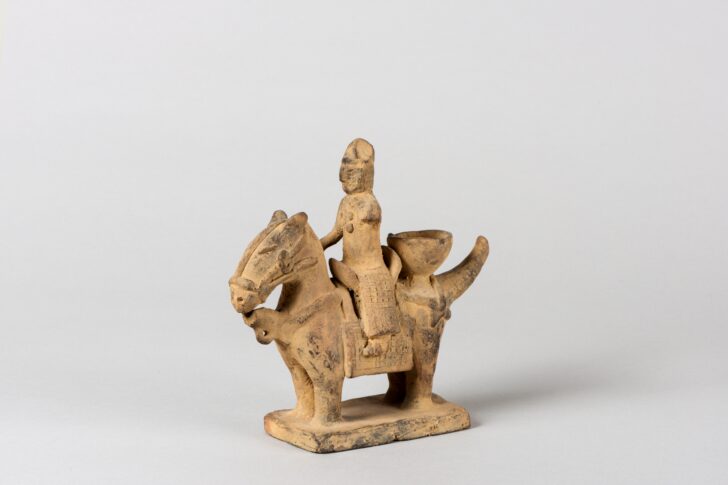Oil Lamp in the Shape of an Equestrian Warrior
Korean

Description
This charming sculpture of a mounted warrior is one of the great treasures of the Hasenkamp-Nam Collection. Sculpted figures of both humans and horses are extremely rare in early Korean pottery, although the importance of the horse to the rulers of the Gaya States and Silla is apparent from the prevalence of elaborate gold and bronze horse trappings in large tombs.
Only a few other examples of equestrian images are known, the most famous being a pair that was discovered in 1924 in the early sixth-century Gold Bell Tomb in Gyeongju, the Silla capital. One of these is a meticulously modeled figure of a warrior prince, while the other is a more simply rendered figure of his servant; both are mounted on stocky, broad-chested horses. Now in the National Museum of Korea, the pair from the Golden Bell Tomb are designated as National Treasures.
This sculpture closely resembles but is smaller than the famous pair from the Gold Bell Tomb. All three works share the same type of horse, a funnel-shaped mouth behind the saddle, and a tube-like spout emerging from the horse’s chest. The Gold Bell pair probably served as ritual ewers, but in this example, the spout is truncated and sealed. The presence of soot in the small hollow of the horse’s body is compelling evidence that this piece functioned as an oil lamp.
Subject Matter:
This kind of earthenware would be used to pour water or drink. A lot of things related to horse was found in the Silla Dynasty tomb because they believed that horse would lead to the heaven. This figure is an important relic to understand the sense of soul of Silla people as well as their costume, weapon, horse equipment, arts and design.
Physical Description:
It is a earthenware with a man riding a small horse with short legs over a thick rectangle plate. There is a lamp-oil container with hole over the hips of the horse, and a spout sticks out in the front breast of the horse, which enables to pour out water through the inside of the stomach of horse. The figure on the horse wears a triangular hat and armor. The left arm is disappeared.
Usage Rights:
If you are interested in using an image for a publication, please visit https://umma.umich.edu/request-image/ for more information and to fill out the online Image Rights and Reproductions Request Form.